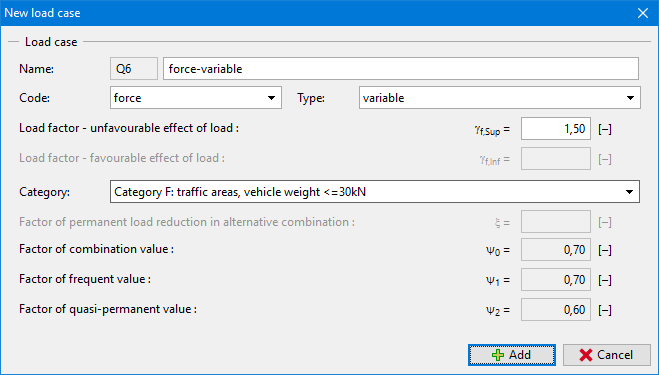Load Case parameters
The following parameters are defined in the "New load case" dialog window:
Load case identifier
The load case identifier, which is composed of the load case number and a uniliteral prefix, is displayed in front of the field for entering the name of the load case. The prefix is determined by the type of load case:
G | - | permanent load |
Q | - | variable load |
A | - | accidental load |
The load case identifier is mainly used in printouts of combinations.
Load case code
The load case code determines, what load can be specified for this load. The following options are available.
Self-weight | - | In this load case the load represents the structure self-weight and it is generated automatically by the program. Only one load case with this code can be considered in each task. |
Force | - | An arbitrary type of force load (forces, moments) can be introduced into the load case with this code. The number of LCs is not limited. |
Load type
It determines the character of load cases based on their variability in time. Selecting a particular type of load corresponds to classification according to EN 1990 standard, art. 4.1.1.
Load coefficients
It allows for specifying the load partial factor γf. This coefficient accounts for unfavorable deviations of values of loads from the representative ones. For permanent load it is necessary to introduce different values for favorable (γf, inf) and for unfavorable (γf, sup) load action in a combination. If the load input follows EN 1990 the default values of coefficients are taken from table A1.2(B).
Category
Classification of load cases into categories corresponds to the classification of load according to table A1.1 of EN 1990 standard. Based on this the variable load cases are assigned combination coefficients ψ0, ψ1 a ψ2. The category of "User-defined input" allows for defining the user self-values of these coefficients. Choosing a category is possible only for load cases input, according to EN 1990 (the "Materials and standards" tab serves to select the particular standard).
Combination coefficients
Basic values of coefficients to create combinations arise from EN 1990 standard and depend on the load case category. When user input is assumed, it is possible to define the user self-values of these coefficients. The following coefficients are used to create a combination:
ξ | - | Coefficient of reduction of permanent loads in alternative combination - this coefficient is assigned to all permanent loads and is used when compiling alternative combinations for the bearing capacity limit state (combination to relation 6.10.b, EN 1990). |
ψ0 | - | Coefficient of combination value - coefficient for variable loads, it is used when compiling combinations for both the bearing capacity and service limit states |
ψ1 | - | Coefficient of frequent value - coefficient for variable loads, it is used when compiling accidental combinations and combinations for the service limit state |
ψ2 | Coefficient of quasi-permanent value - coefficient for variable loads, it is used when compiling accidental combinations and combinations for the service limit state |
The combination coefficients are available only for load cases input according to EN 1990 (the frame "Analysis methods" serves to select the particular standard).
 Dialog window "New load case"
Dialog window "New load case"